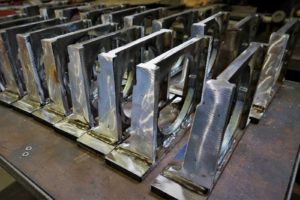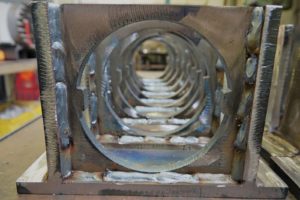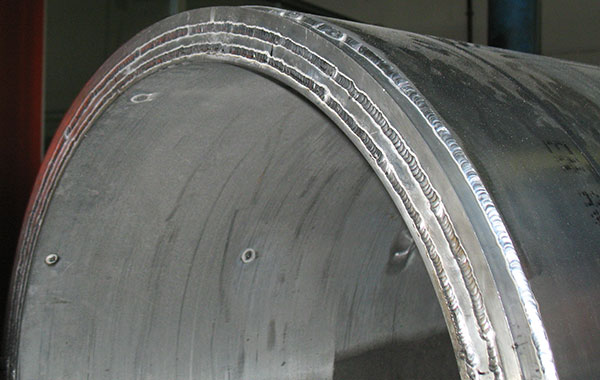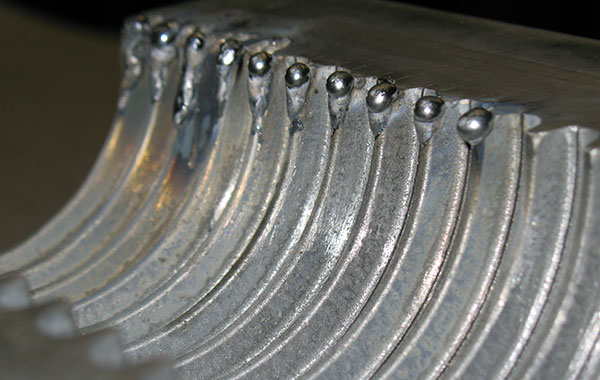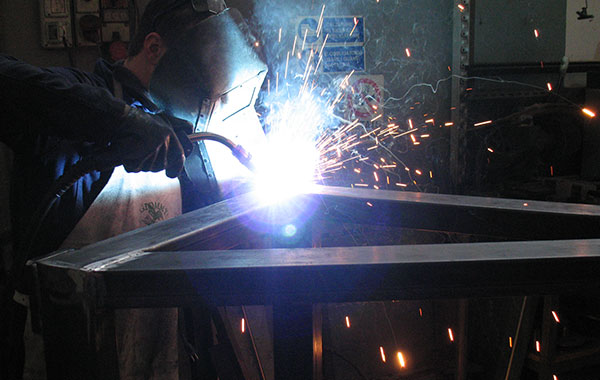Welding UFG
Welding is a process that allows the physical / chemical union of 2 joints by fusing them or by means of metal. This process is very important to ensure a high quality finished product and for this reason UFG srl uses modern welding equipment and skilled and competent personnel.
Welding is a highly productive and economical machining that guarantees reliability in the construction of welded mechanical members. UFG has invested in modern technology in recent years. Thanks to the mature experience, welding has now led to a very high quality / economic standard.
SMAW Shielded Metal Arc Welding
Shielded Metal Arc Welding, is a very common technology for its low cost and versatility of use.
Arc welding with electrode is a manual process where the thermal source is made up of an electric arc that, between the coated electrode and the piece, develops the heat necessary to create the melting bath where the gas produced by the electrode coating protects from the atmosphere, this process causes the melting of the basic material and the electrode itself.
This process is suitable for the welding of ferrous and non-ferrous metal alloys excluding aluminum alloys.
OFW – OxiFuel gas Welding
Manual braze welding is a machining process that consists of joining two metal pieces with the aid of an inboard metal without the melting of the pieces to be joined. The penetrating metal penetrates homogeneously between the pieces to be joined, thus obtaining excellent mechanical and hydraulic tightness. The welding material can be welded between different metals, the material used is brass and bronze with a melting point of 900 ° C.
Braze welding
Braze welding, or strong brazing , is known as brass welding and is used to weld steel, cast iron, copper and alloys, merging with high melting point material (900 ° C). The oxyacetylene torch is used for preheating the flaps and the fusion of the feed material is used.
Brazing, or sweet brazing, is also known as soldering. Filling metal penetrates through the welding pieces (zinc, tin, steel, copper, and alloys) and is usually a low melting material (such as a tin-lead alloy, said welding pond), melted through an oxyacetylene gas rod.
Braze welding can be used in these cases:
- Welding two metals of different nature
- Welding of uncertain metals between them
- When you need to reduce or limit deformations on the metals to be joined
- When finishing the pieces to join is not a priority
Braze welding does not guarantee the same characteristics of “robustness” as the autogenous welding does.
The metals that can be braze welded are:
- Steels in general
- Stainless steels
- Carbon steels
- Copper and its alloys
- Bronzes
- Brass
For repair:
- Cast irons
- Aluminum and its alloys
- Nickel and its alloys
Copper and brass alloys are used as filling metals with special additives such as silicon and manganese, nickel, silver or tin. Aluminum alloys use silicon aluminum alloys.
Automatic braze welding
Automatic brazing is performed on small to medium size parts to ensure aesthetically sealed and high quality, optimizing value for money and is used on medium and large production batches.
MIG/MAG Welding (Metal-arc Inert Gas – Metal-arc Active Gas)
MIG and MAG welding differ for the gas used to protect the welding bath, both of which are known as GMAW (Gas Metal Arc Welding). This process is characterized by the use of a continuous wire as a positive pole and a negative pole formed by the soldering piece in which the welding cap is secured by an inert gas that is delivered by the torch on the workpiece to be soldered.
Continuous wire MAG welding is a process in which the melting bath is protected by a cover gas flowing from the torch onto the workpiece. The process guarantees high productivity while at the same time increasing the economics of the process thanks to the gas that allows to obtain a welded welding cord unlike the coated electrode welding.
The process is applied to bonded and weakly bonded steels where the oxidizing elements of the mixture are dosed to stabilize the arc and also to stabilize the mechanical characteristics in the final weld.
MIG and MAG properties
- Ease of use in different positions
- The method is applied to many fields in the industry
- The system is used in a robotic or manual way
Welded materials:
- Copper
- Aluminum alloys
- Stainless steels (AISI 304L, AISI 316L, ecc)
- Steel alloys
- Acciai non legati
Merchandise sector: Naval, Petrochemical, Automatic Machines, Metal Carpentry, Medical, Food, etc.
TIG welding (tungsten inert gas)
Arc welding procedure with infusible (tungsten) electrode, under inert gas protection, which can be performed with or without inert metal.
The machining provides high quality joints. The base process on a torch in which the tungsten electrode around which the protective gas flows is passed through a nozzle of ceramic material to the melt bath. The operation can be carried out without an intake metal where the torch moves along the joint to move the melting bath, while the welding with injecting metal the torch moves simultaneously with the wand of the material in such a way as to keep it constantly with the end within the arc.
Properties:
- High metallurgical quality
- Aesthetic and clean welds
Ways of use:
- Manual
- Automatic
Materials:
- Steel alloys
- Non-alloy steels
- Stainless steels (AISI 304L, AISI 316L, ecc)
- Light alloys
- Special alloys
- Titanium
Merchandise sector: naval, petrochemical, automatic machines, metallic carpentry, medical, food, etc.c.
 Italian
Italian English
English

